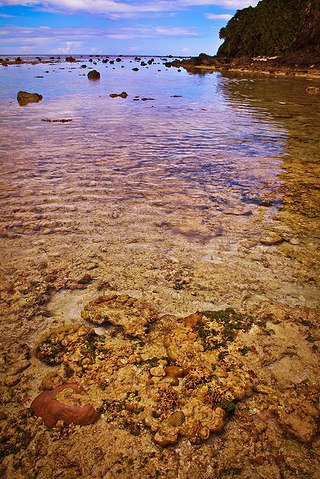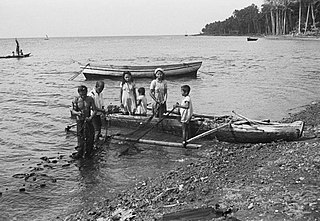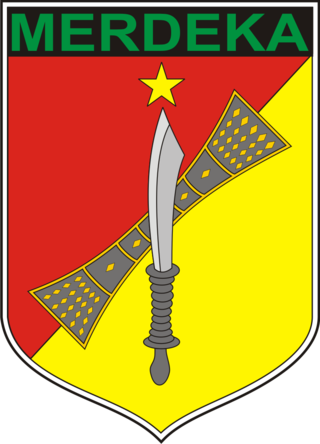
North Sulawesi is a province of Indonesia. It is located on the Minahasa Peninsula of the island of Sulawesi, south of the Philippines and southeast of Sabah, Malaysia. It borders the Philippine province of Davao Occidental and Soccsksargen regions of the Philippines to the north, the Maluku Sea to the east, Gorontalo and Celebes Sea to the west and the Gulf of Tomini to the southwest. With the outlying island of Miangas to its north, it is the northernmost island of Indonesia. The province's area is 14,500.28 square kilometres (5,598.59 sq mi), and its population was 2,270,596 according to the 2010 census; this rose to 2,621,923 at the 2020 Census, while the official estimate as at mid 2022 was 2,659,543. North Sulawesi is known as a heaven for divers around the world.

The Minahasans or Minahassa are an indigenous ethnic group from the North Sulawesi province of Indonesia, formerly known as North Celebes. The Minahasa people sometimes refer to themselves as Manado people. Although the Minahasan pre-Christian creation myth entails some form of ethnic unification, before the nineteenth century the Minahasa region was in no way unified. Instead, a number of politically independent groups (walak) existed together, often in a permanent state of conflict.

Manado is the capital city of the Indonesian province of North Sulawesi. It is the second largest city in Sulawesi after Makassar, with the 2020 census giving a population of 451,916, and the official estimates for mid 2022 showing 454,606 inhabitants, distributed over a land area of 157.26 km2. The Manado metropolitan area had a population of 1,365,237 as of mid 2022. The city is located adjacent to the Bay of Manado, and is surrounded by a mountainous area.

Datu is a title which denotes the rulers of numerous indigenous peoples throughout the Philippine archipelago. The title is still used today, though not as much as early Philippine history. It is a cognate of ratu in several other Austronesian languages.
Mongondow, or Bolaang Mongondow, is one of the Philippine languages spoken in Bolaang Mongondow Regency and neighbouring regencies of North Sulawesi (Celebes) and Gorontalo Provinces, Indonesia. With more than 200,000 speakers, it is the major language of the regency. Historically, it served as the official language of the Bolaang Mongondow Kingdom.

Dr. Gerungan Saul Samuel Jacob Ratulangi was a Minahasan teacher, journalist, politician, and national hero from North Sulawesi, Indonesia. He was part of the committee that ratified the Constitution of Indonesia and served as the first Governor of Sulawesi.

The timawa were the feudal warrior class of the ancient Visayan societies of the Philippines. They were regarded as higher than the uripon but below the tumao in the Visayan social hierarchy. They were roughly similar to the Tagalog maharlika caste.

In early Philippine history, barangay is the term historically used by scholars to describe the complex sociopolitical units that were the dominant organizational pattern among the various peoples of the Philippine archipelago in the period immediately before the arrival of European colonizers. Academics refer to these settlements using the technical term "polity", but they are usually simply called "barangays".

The Sultanate of Bulungan was a princely state of Indonesia located in the then existing Bulungan Regency in the east of the island of Borneo. Its territory spanned the eastern shores of North Kalimantan and Tawau, Malaysia.

Minahasa Regency is a regency in North Sulawesi, Indonesia. Its capital is Tondano. It covers an area of 1,141.64 km2 and had a population of 310,384 at the 2010 Census; this rose to 347,290 at the 2020 Census, and the official estimate as at mid 2022 was 350,317.

Miangas or Palmas is North Sulawesi's northernmost island, and one of 92 officially listed outlying islands of Indonesia.
Kedatuan were historical semi-independent city-states or principalities throughout ancient Maritime Southeast Asia in the present-day Philippines, Indonesia, and Malaysia. In a modern Indonesian/Malay sense, they could be described as kingdoms or polities. The earliest written record mentioning the term kadatuan was the 7th-century Srivijayan Telaga Batu and Kota Kapur inscription from Sumatra, Indonesia.

Sangirese or Sangihe people are one of the native people to the Sangir Islands in the northern chain of islands in Sulawesi and the southern part of Mindanao. The Sangirese people are fishermen and nutmeg growers in their home areas and also work as wage labourers in industrial crops enterprises in Bolaang Mongondow Regency and Minahasa Regency.

The Mongondow or Bolaang Mongondow people are an ethnic group native to the north-eastern part of the Indonesian island of Sulawesi. The Mongondows are predominantly Muslim. They have traditionally been concentrated in the provinces of North Sulawesi and Gorontalo. This ethnic group used to be united by a single entity, the Kingdom of Bolaang Mongondow, which became the western regencies of North Sulawesi after the Indonesian independence.

Gorontalo is a province of Indonesia on the island of Sulawesi. Located on the Minahasa Peninsula, Gorontalo was formerly part of the province of North Sulawesi until its inauguration as a separate province on 5 December 2000. The province is bordered by the provinces of North Sulawesi to the east and Central Sulawesi to the west, as well sharing a maritime border with the Philippines to the north. The provincial capital, as well as the main gateway to the province and its most populated city, is Gorontalo.

Bernard Wilhelm "B. W." Lapian was a nationalist involved in the struggle for Indonesian independence. He published several newspapers that gave voice to the welfare of the Indonesian people and promoted Indonesian nationalism. He was also part a group who established a separate Christian denomination from the official Dutch East-Indies church institution. After Indonesia gained its independence, Lapian served as head of the district of Manado and acting governor of Sulawesi. In 2015, he was given the title of National Hero of Indonesia by President Joko Widodo.

The term Paramount Ruler, or sometimes Paramount Datu, is a term used by historians to describe the highest ranking political authorities in the largest lowland polities or inter-polity alliance groups in early Philippine history, most notably those in Maynila, Tondo, Pangasinan, Cebu, Bohol, Butuan, Cotabato, and Sulu.
This is a list of emblems or coat of arms used in Indonesia. Indonesia is divided into 38 provinces, and each province is divided into regencies (kabupaten) and cities (kota). There are 416 regencies and 98 cities. Each province, regency, and city has its own emblem.

Komando Daerah Militer XIII / Merdeka is a Defense Regional Military Command which is responsible for the defense of the provinces of North Sulawesi, Gorontalo and Central Sulawesi.

Stevanus Vreeke Runtu was an Indonesian politician. He was the Regent of Minahasa from 2003 until 2013. Prior to becoming a regent, Runtu was a longtime member of the Minahasa Regional People's Representative Council, having served in the council from 1987 until 2002.














